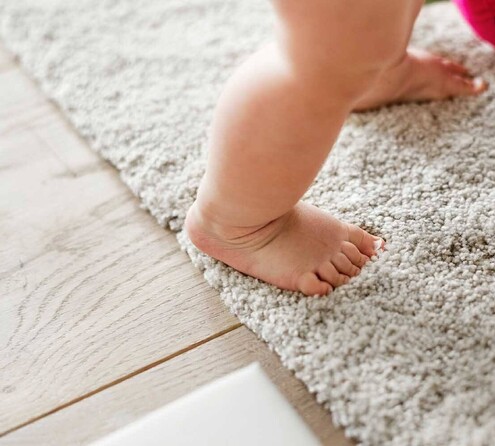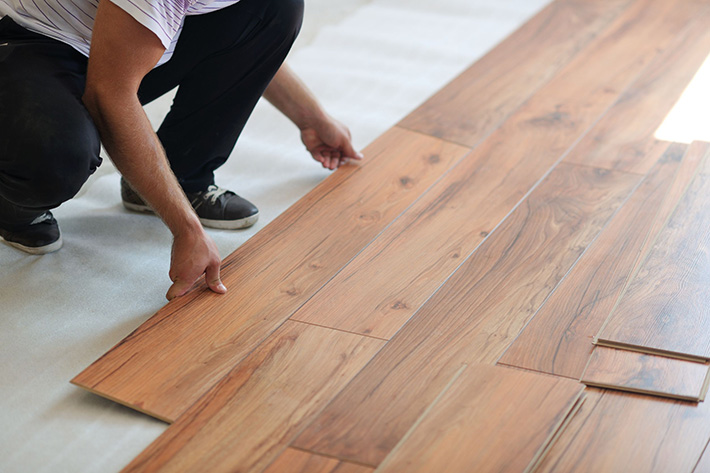Household products such as detergent, floor and furniture polish, paints, and various cleaning products for glass, wood, metal, ovens, toilets, and drains may contain hazardous chemicals. When not properly handled, these products can make the home or care environment a dangerous place, especially for kids. They can make indoor air unhealthy to breathe, irritate the skin and eyes, harm the endocrine system, increase cancer risks, and pollute the natural environment. Instead, look for third party certified green products.


Carpets and household furnishings can trap pesticides, household cleaning residues, and lead-contaminated dust and dirt. They can also release harmful chemicals such as formaldehyde, flame retardants, and per- and polyfluoroalkyl substances (PFAS). These chemicals are associated with skin, eye, and mucous membrane irritation, headaches, nausea, disrupted hormone function, developmental and reproductive harm, and even an elevated cancer risk. Children, especially younger children, spend most of their time near or on the ground and thus breathe in these chemicals, as well as the dirt, dust, and mildew that accumulate in carpets and household furniture.
Some paints give off fumes that can harm babies and children’s health. The classic “new paint smell” is actually due to volatile organic compounds (VOCs). These compounds are breathed in through the air and are associated with an increased risk for childhood cancer when parents and/or kids are exposed. They can also cause irritation to your eyes, nose, and throat, or impact your liver, kidney, and nervious system. Some paints also contain chemicals that can disrupt hormones, called Alkylphenol ethoxylates (APEs). Others that are advertised as antimicrobial or antifungal contain harmful pesticides and preservatives.


Even the materials we use to build can pose threats to health. Lead in water pipes, treated wood in play sets, asbestos, or even the flooring we use can make adults and kids sick. Thankfully, there are healthier alternatives to each of the issues we’ve mentioned, and lots of people are working to make safe options easy to find and use!
Creating safer and healthier child care settings–free of harmful environmental hazards–is key to protecting the safety and well-being of our nation’s children. Young children are the most vulnerable to toxic exposures, and many spend 8 or more hours in their child care facility each day. Environmental health requirements for child care varies by state, leaving many providers to do their own research or rely on voluntary accreditation or endorsement.
Safe siting means choosing safe locations for schools, homes, community centers, parks, and child care facilities so that children and adults can avoid exposures from environmental hazards Where these places are located, and what was in the space before them, can have an effect on the types and amounts of environmental exposures children may be exposed to. For example, a child care facility could be located near or in close proximity to: a gas station, dry cleaner, nail salon, funeral home or housed within a formerly polluted industrial building, all of which can increase exposure to harmful chemicals.
The places we sleep, live, and play have a big impact on our health! This is especially true for children. Healthy homes set children up to thrive.
Discriminatory housing practices like redlining and segregation, which restrict where people of color can buy houses or live, impact the health and safety of neighborhoods and houses. Practices like redlining segregated communities and encourage the siting of polluting industries and highways in these neighborhoods instead of White communities, polluting the air, water, and soil. Redlining and segregation also made (and continue to make) it more difficult for people of color to move into healthier neighborhoods. These racist policies also led to intentional disinvestment, especially from urban-center communities of color. Because of this, children in these areas are more likely to live in housing of poorer quality and with health hazards, and their lower tax base results in schools in poorer condition as well.
Healthy Homes can also mean healthier child care- many early learning and care professionals operate out of their homes.
Eco-Healthy Child Care® (EHCC) is a national program of the Children’s Environmental Health Network that partners with child care professionals to eliminate environmental hazards found in and around child care facilities.
EHCC develops training and education materials for child care providers and caretakers, as well as running a special program that endorses child care providers who educate their employees and use science-backed best practices to protect kids’ health. These eco-healthy changes immediately benefit the well-being of young children and staff and create toxic-free early care and learning settings. EHCC also provides education, training, and resources for child care professionals, and is working across coalitions to advance environmental protections for all children in child care across the country.
The Agency for Toxic Substances and Disease Registry (ATSDR) has created the Choose Safe Places for Early Care and Education Program to encourage the careful consideration of where to locate child care facilities. It offers towns, cities, and states guidance on how to adopt practices that ensure child care facilities are located away from chemical hazards. Twenty-eight states (grantees of ATSDR’s Partnership to Promote Local Efforts to Reduce Environmental Exposure) have received federal funding to support the creation of safe siting initiatives in their communities. Since 2017, the EHCC program has collaborated with the Environmental Law Institute and the National Association of County and City Health Officials to assist ATSDR in providing support to state health departments in implementing the Choose Safe Places for Early Care and Education Guidance program.